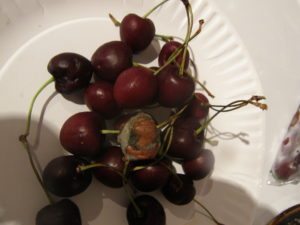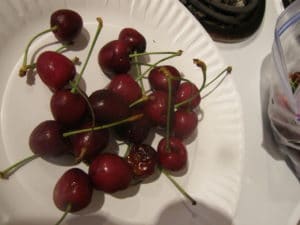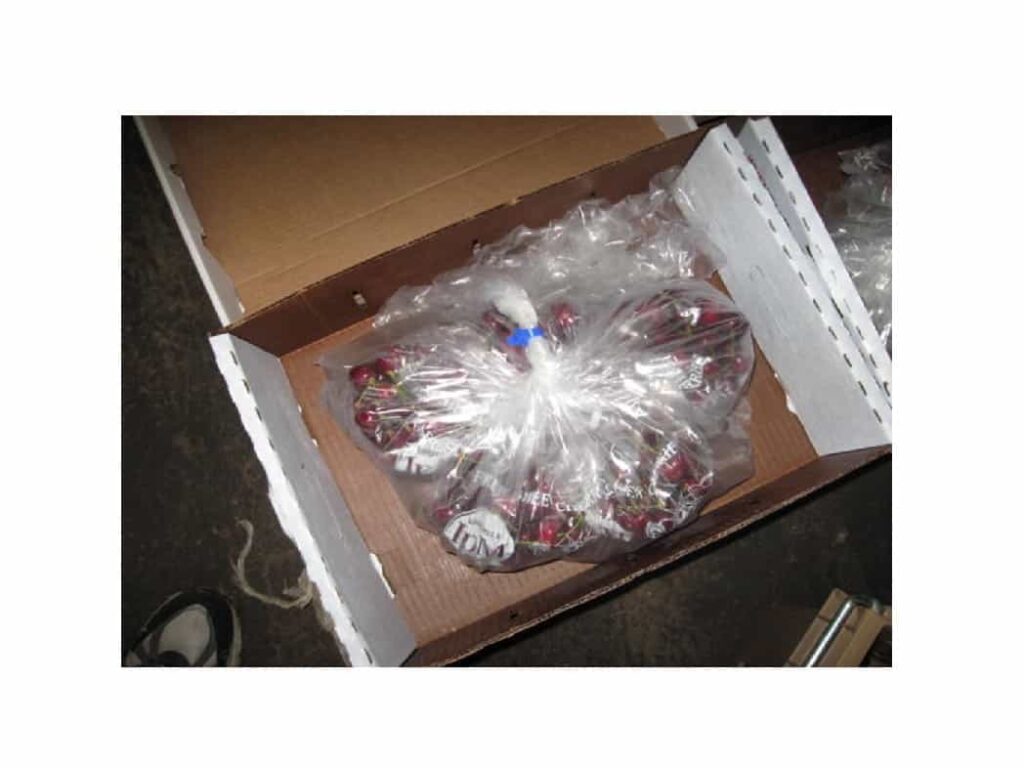Sweet Cherries: A MAP for the Future
Craig Kahlke engaged local growers in trials of a new preservation method for sweet cherries.
Welcome to the Northeast SARE Spotlight! SARE (Sustainable Agriculture Research and Education) offers grants to farmers, educators, universities and communities that are working to make agriculture more sustainable – economically, environmentally, and socially. Learn about whether a SARE grant would be a good fit for you.
Drive along the shore of Lake Ontario in the early summer, and you’ll find the trees bursting with plump, luscious cherries. For fruit lovers, this sight is a colorful reminder that summer is finally here. But for the small orchards along this stretch of the lake, cherry season always presents a challenge. Unlike apples, which can last for months with proper storage, cherries turn soft and moldy after only a few weeks.
Most growers find themselves rushing to sell their cherries before they go bad, which means lowering prices and often losing money.
The logistical difficulties of marketing cherries inspired Craig Kahlke, the Fruit Quality Management Specialist for Cornell Cooperative Extension’s Lake Ontario Fruit Program, to apply for a SARE grant to experiment with storing cherries in modified atmosphere packaging bags (MAPs). MAPs are special micro-perforated polymer storage bags or liners that decrease the respiration rates of cherries by maintaining a low oxygen concentration while at the same time allowing carbon dioxide to build up. High levels of carbon dioxide in the liners increase antimicrobial activity and therefore reduce storage rots. This keeps certain varieties of cherries fresh–and saleable–for longer. For the SARE project, which was a Partnership grant, six growers in Western New York stored portions of their harvest in the MAP bags. They hoped that these cherries would still look and taste fresh weeks after they would otherwise have gone bad.
The SARE Project
Applying for the SARE grant “was a pretty painless process,” Craig says. “It was quite clear what [the organization] wanted.” Getting help from others made the process particularly straightforward. Craig recommends going to a grant writing workshop and asking previous grant recipients in your area for advice. If you’re planning to apply for a partnership grant, you also want to ensure the support of local growers. Since Craig already had working relationships with several cherry growers, like Jim Bittner of Singer Farms (Appleton), Gary and Stephanie Craft of G&S Orchards (Walworth), and Guin Panek and Jeff Smith of Ledge Rock Farms (Medina), he says it was easy to involve them in the grant process.
Craig emphasizes that you don’t need a lot of experience to get started—just an idea. “I had only been with Extension about 6 months,” he says. “I didn’t know much about the sweet cherry industry.” The idea for using MAPs came about when he attended a presentation by Herb Cooley, a researcher at the Department of Food Science at the New York State Agricultural Experiment Station (NYSAES) at Geneva. Based on the work Herb was doing under Dr. Olga-Padilla Zakour, the presentation illustrated how MAPs–when used together with other quality improvement techniques like hydro-cooling–could extend cherry shelf-life by 2-4 weeks.
Craig wanted to see if the bags would work for local growers. When he started talking to growers about the idea, they expressed a lot of enthusiasm. “If you can buy me two weeks to sell my sweet cherries, that’s worth my money,” Jim Bittner told Craig, Olga and Herb emphatically.
Taste Test
Throughout the growing season, the growers participating in the project compared sweet cherries stored in MAPs to un-bagged controls. At weeks 4, 5, and 6, they gave the cherries in each condition one of four possible ratings—fresh, acceptable, fair, and unacceptable—based on texture, flavor and appearance. Even after four weeks, they could see a dramatic difference. Almost all the un-bagged cherries, soft and dark with decay, were clearly unacceptable.
In contrast, many of the MAP-stored cherries still exhibited the bright-red flush and green stems of the day they were picked. Some even stayed near-fresh for over six weeks. One farm, Craig says, sold its cherries “in the MAP five weeks after harvest and they tasted like they were harvested that day. The customers were really happy with them.”
Some cherry varieties emerged from the bags in better condition than others. Firmer cherry cultivars, such as Hudson, Sam, Schmidt, 19, and Emperor Francis, seemed to be the most successful, while growers had less luck with large, softer cherries, such as Regina and Hedelfigen. “Some varieties, like Lapins, would hold up well in the liners for a few weeks,” Craig explains, “but they’d lose their stems, which would likely not be accepted in the marketplace.” He urges farmers to first test individual varieties on a small scale, so they can make sure the varieties will thrive in that particular farm’s growing, packing, cooling, and storage conditions.
A MAP for the Future
Prolonging storage can help local cherry farmers compete with growers in the Pacific Northwest. And at 50 cents each, MAP liners prove well worth the investment. But you can’t just pack some cherries in a MAP liner and assume they’ll taste good in five weeks. The liners work best when combined with other techniques, like hydro-cooling and picking cherries at the right maturity. And while the MAP liners keep good cherries fresh, it won’t make bad cherries juicy and delicious, so if you want quality results, you need to use high quality fruit—and take care of the fruit immediately after harvest! “Cool your fruit as rapidly as possible after harvest to remove field heat,” Craig says. “A general rule of thumb for highly perishable crops like sweet cherries is that for every hour delayed in cooking, a day of shelf life is lost.”
Now that the SARE project has demonstrated the liner’s effectiveness, it’s time to get more growers to invest in the new technology. To date, Craig has presented these findings to over 250 growers and industry members at two regional fruit meetings, and he plans to write a follow-up article and place advertisements in local newsletters. But personal outreach might be the most effective way to spread the word. By encouraging individual growers to start using MAP liners, Craig might just make the three-week cherry season a distant memory.
Participating Growers
In addition to the growers mentioned in this article, the farms/growers that participated in this project were Alan Buhr of Newroyal Orchards (Gasport), Roger Lamont of Roger Lamont Fruit Farm (Albion), and Kent Schwab of Schwab Farms (Gasport). Growers who had planned on cooperating but were unable to due to untimely rain and excessive cracking of the fruit were Jack Torrice of Fruit Valley Orchard (Oswego) and Philip Wager of Wager’s County Apple in Red Creek. An additional 5 growers have tested MAPs on their farms in past years.
This article discusses SARE grant ONE10-119. View the final report. For more information, contact Craig Kahlke at cjk37@cornell.edu.
Upcoming SARE Grant Deadlines
Sustainable Community Grants – Due late fall/early winter
Sustainable Community Grants are for projects that strengthen the position of sustainable agriculture as it affects community economic development. Communities and commercial farmers must benefit from these proposals, and the selection emphasis is on model projects that others can replicate.We also look for projects that are likely to bring about durable and positive institutional change and for projects that benefit more than one farm. Grants are capped at
$15,000.
Partnership Grants – Due late fall/early winter
Partnership Grants are for agricultural service providers–extension staff, consultants, nonprofits, state departments of agriculture, and others working in the agricultural community–who want to conduct on-farm demonstrations, research, marketing, and other projects with farmers as cooperators. Partnership Grants allow agricultural service providers to explore topics in sustainable production and marketing in cooperation with client farmers. The goal is to build knowledge farmers can use, encourage the understanding and widespread use of sustainable techniques, and strengthen working partnerships between farmers and farm service providers. Projects must take place on farms or directly involve farm businesses. Reviewers look for well-designed inquiries into how agriculture can enhance the environment, improve the quality of life, or be made more profitable through good stewardship. Grants are capped at $15,000.
Farmers Grants – Due late fall/early winter
Farmer Grants are for commercial producers who have an innovative idea they want to test using a field trial, on-farm demonstration, or other technique. Farmer Grants let commercial producers explore new ideas in production or marketing; reviewers look for innovation, potential for improved sustainability and results that will be useful to other farmers. Projects should be technically sound and explore ways to boost profits, improve farm stewardship, or have a positive impact on the environment or the farm community. Grants are capped at$15,000.





I believe I have a Montmorency cherry tree I need some help with caring for it. It’s quite large and this year for the first time since we moved it the puree produced Cherry’s. The issue is the trees not looking good. Lots of large death branches. We’re not sure what the best way is to bring this tree back. Is it too far gone. What does it need ? Happy to send photos
Hi,
I’d recommend reaching out to your local Cooperative Extension specialist with your question. You can find your local contact at this link: https://smallfarms.cornell.edu/contact/local-contacts/